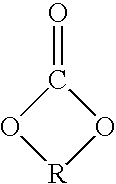Melt spun polyether TPU fibers having mixed polyols and process
a polyether and polyol technology, applied in the field of melt spun polyether tpu fibers, can solve the problems of low dye pickup with dispersive dyes, poor wet fastness, and inability to melt spun tpu fibers, etc., to achieve good wet fastness, less pressure buildup, and good elastic properties
- Summary
- Abstract
- Description
- Claims
- Application Information
AI Technical Summary
Benefits of technology
Problems solved by technology
Method used
Image
Examples
example 3
[0064]A preheated to 120° C. mixture of: 54.8968 parts by weight of polyether intermediate (PTMEG) of molecular weight (Mn) 2000, 23.5272 parts by weight of of polyether intermediate (PTMEG) of molecular weight (Mn) 1000, 8.2149 parts by weight of benzene glycol (HQEE) chain extender, 0.3 parts by weight of antioxidant and 0.3 parts by weight of UV stabilizer, was reacted at a temperature of 200° C. with 21.5760 parts by weight of MDI and 0.4 parts by weight of lubricant in a 40 mm co-rotating twin screw extruder in the presence of 50 ppm stannous octoate acting as a catalyst. The resulting polymer was underwater pelletized and collected in a silo heated at 105° C. to dry the product. The resultant TPU had a molecular weight (Mn) of 150,000 Dalton and was used in Example 7 to make melt spun fibers.
example 4
[0065]A preheated to 120° C. mixture of: 60.1952 parts by weight of polyether intermediate (PTMEG) of molecular weight (Mn) 2000, 10.6227 parts by weight of polyether intermediate (PTMEG) of molecular weight (Mn) 1000, 6.6878 parts by weight of benzene glycol (HQEE) chain extender, 1.6719 parts by weight of hydroxyl ethyl resorcinol (HER) co-chain extender, 0.3 parts by weight of antioxidant and 0.3 parts by weight of UV stabilizer, was reacted at a temperature of 200° C. with 20.82 parts by weight of MDI and 0.4 parts by weight of lubricant in a 40 mm co-rotating twin screw extruder in the presence of 50 ppm stannous octoate acting as a catalyst. The resulting polymer was underwater pelletized and collected in a silo heated at 105° C. to dry the product. The resultant TPU had a molecular weight (Mn) of 150,000 Dalton and was used in Example 7 to make melt spun fibers.
example 5
[0066]A preheated to 120° C. mixture of: 59.8450 parts by weight of polyether intermediate (PTMEG) of molecular weight (Mn) 2000, 14.9612 parts by weight of polyether intermediate (PTMEG) of molecular weight (Mn) 1000, 5.003 parts by weight of benzene glycol (HQEE) chain extender, 1.2508 parts by weight of hydroxyl ethyl resorcinol (HER) co-chain extender, 0.3 parts by weight of antioxidant and 0.3 parts by weight of UV stabilizer, was reacted at a temperature of 200° C. with 18.94 parts by weight of MDI and 0.4 parts by weight of lubricant in a 40 mm co-rotating twin screw extruder in the presence of 50 ppm stannous octoate acting as a catalyst. The resulting polymer was underwater pelletized and collected in a silo heated at 105° C. to dry the product. The resultant TPU had a molecular weight (Mn) of 150,000 Dalton and was used in Example 7 to make melt spun fibers.
PUM
| Property | Measurement | Unit |
|---|---|---|
| number average molecular weight | aaaaa | aaaaa |
| number average molecular weight | aaaaa | aaaaa |
| number average molecular weight | aaaaa | aaaaa |
Abstract
Description
Claims
Application Information
 Login to View More
Login to View More - R&D
- Intellectual Property
- Life Sciences
- Materials
- Tech Scout
- Unparalleled Data Quality
- Higher Quality Content
- 60% Fewer Hallucinations
Browse by: Latest US Patents, China's latest patents, Technical Efficacy Thesaurus, Application Domain, Technology Topic, Popular Technical Reports.
© 2025 PatSnap. All rights reserved.Legal|Privacy policy|Modern Slavery Act Transparency Statement|Sitemap|About US| Contact US: help@patsnap.com



